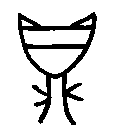I Ching, Yijing or Zhou Yi
"Oracle of the moon": © 2000 LiSe
 Yi Jing, Oracle of the Moon
Yi Jing, Oracle of the Moon

The Ding-sacrifice and setting the seasons right
The family of Dĭng (the cauldron of hex.50), zhēn (divination), and Dìng (an asterism and 'setting right').

https://en.wikipedia.org/wiki/
Nine_Tripod_Cauldrons
Members of the scholarly gentry class were permitted to use one or three cauldrons; the ministers of state five; the vassal lords seven; and only the sovereign Son of Heaven was entitled to use nine.
It was important to know the exact north. Nowadays we can find the Polestar/Northpole by drawing a line through two stars in the Big Dipper, but the Polestar moves, so a few thousand years BCE two stars in the asterism Dìng were used to find the location of the Northpole.

During the mid-Zhou dynasty two stars of the asterism Ding, the great square of Pegasus, were used to find the northern center of the heavens. The name Dìng was written as a square □.
The characters in the group of dĭng and zhēn all have the root 'rectify' (make straight, square up).
Asterism Dìng 定 is the celestial square or Temple, and in its earliest form, dīng 丁, it is written □, a square. Dìng 定 is a very common character: to fix.
Zhèng 正 means regular, set right, standard (the first month of the calendar is zhèng).
Zhēn 貞 (in Wilhelm 'perseverance') is proclaiming the divinatory incantation (probably during a ritual Ding-sacrifice), submit to the oracle and to introduce the charge to the bone in the Shang divinations.
See the article by David Pankenier "Getting 'Right' with Heaven and the Origins of Writing in China" (www.academia.edu).